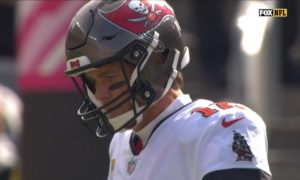While the Pittsburgh Steelers may have gained some tangible evidence of improvement, improving their win total by three games and hosting a playoff game as a division champion for the first time in four seasons, there is no doubt that the team is far from a finished product.
No team, of course, is a finished product in the offseason. Every team loses players to free agency and retirement, and replaces them through the same free agency process, as well as the draft.
With all of the change that occurs during the offseason, it’s often difficult to predict how a particular team might fare. They may wind up holding the Lombardi trophy or the first overall draft pick when all is said and done.
In order to gain a better feel for not only the issues facing the team this year, but how those issues might play out, it’s useful to take the devil’s advocate approach. This is the pessimistic side of the coin.
Question: Should the Steelers be looking for a backup quarterback in the draft?
The Steelers have long held the tradition of carrying three quarterbacks on their 53-man roster, at least for as long as I can recall off-hand. But doing so has become a bit less valuable in recent years with changes to the way the game day active roster is utilized.
Previously, a team would deactivate eight players per week, which would include the third quarterback, but the third quarterback could dress and enter the game if the first two quarterbacks were injured.
The league did away with this caveat, instead simply changing the game day inactive list from eight players to seven. And since the Steelers drafted Landry Jones two seasons ago, he has yet to be active for a single game.
What value, then, is there in having a third quarterback on the roster—or at least a third quarterback who is Landry Jones, who may just as easily slip onto the practice squad with nobody else sniffing around?
Then the question comes about whether or not to replace Jones as the third, typically developmental quarterback. The argument in favor of this is generally strong, but is the course of action here to simply draft yet another quarterback in the back half of the draft?
The Steelers have had close to no success doing so behind Ben Roethlisberger. The closest approximation of ‘success’ in this regard, I suppose, would be Dennis Dixon, whose greatest accomplishment with the Steelers was not actively losing games. But he benefitted from stellar defense during his highlights from the team, which Pittsburgh no longer has on the menu.
Go ahead and take a look back on the quarterbacks the Steelers have selected over the years, outside of Roethlisberger, and follow their career trajectory? Who is the last one to make any kind of name for himself in the league as a decent backup quarterback among these mid- to late-round picks?
There has been very little success—disproportionately little success—among quarterbacks drafted late, in comparison to other positions, which suggests that it is a position more than others after a certain point in which the risks greatly outweigh the rewards. Invoking the magic name of Tom Brady does not alter the logic in drafting a quarterback in the fifth round in the hopes that you can groom him to replace Roethlisberger in four or five years.
On the other hand, the Steelers have found success finding backups for Roethlisberger in the free agent market with experienced veterans with former starting experience, from the man he replaced, Tommy Maddox, to his current clipboard holder, Bruce Gradkowski.
Unless you’re looking for the heir apparent now—and if you were, you wouldn’t be looking in the fourth round or later—I question the value of drafting quarterbacks late in the draft. The Steelers’ own draft history is a microcosm of the late-round quarterback landscape. Instead of trying to replace Jones, I would simply try to slip him onto the practice squad. And if they happen to lose him, so be it. He can be replaced fairly easily.








